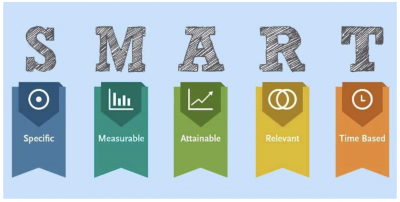
SMART is an acronym for the requirements you should meet when developing the goal statement for your project charter. Let’s define the requirements of SMART, the benefits of meeting those requirements, and some best practices on how to develop and use the SMART approach.
Overview: What is SMART?
SMART is linked to the goal statement as written in your project charter, and will usually be a confirmation or additional clarification of your project goals. Your goal statement is written in the form of a directional definition of the desired outcomes of your project.
Here is what SMART stands for.

Image source: www.toolshero.com.
- Specific: A specific goal is a goal that has some level of detail. It isn’t just, “I want to reduce defects.” More specifically, “I want to reduce paint defects from the current level of 10,000 DPMO to 500 DPMO within 4 weeks after the project is completed and improvements implemented.” Specificity and directional change are important so you know exactly what needs to be done for the project to be deemed successful.
- Measurable: A measurable goal is one that is described in terms of metrics and numerical values. Reducing the current level of defects from 10,000 DPMO to 500 DPMO is measurable since we can count the number of defects and compute the reduction in defects as a percentage or an absolute reduction in numbers.
- Attainable: An attainable goal is a goal you can actually accomplish. Although it’s good to have a stretch goal, being overly optimistic and unrealistic will detract from your project and result in frustration.
- Relevant: Be sure your goal is linked to the desired outcomes of your project. If your project is trying to reduce defects, don’t set a goal to reduce the time to rework defective products.
- Time-bound: Your overall goal is to complete your project. When writing your goal statement, be sure to include a time frame in which to accomplish the work. Your goal statement should not be open-ended and your time frame should be reasonable and achievable.
Your project goals will come from your customer expectations or requirements, your business requirements, competitor performance, government regulations, or benchmarking against the best of the best. Once your goal statement is written, you can then apply the SMART format to validate that your goal statement conveys the right message.
3 benefits of SMART
Using SMART is a smart way to evaluate your goal statement. Here are some of the benefits.
1. Provides clarity, focus, and motivation
By providing the specificity and detail suggested by SMART, you will have greater clarity as to the goal of your project and can focus on the core objectives without getting distracted.
2. Validates your project goal statement
Assessing your goal statement against the format of SMART will confirm whether you have captured the essence of your project goal or if you need to do a rewrite and revision.
3. Good for short-term goal setting
Although some people say SMART can lack flexibility for the long term, it’s very useful for the short-term goals of your project. Hopefully, your Lean Six Sigma project won’t drag on and become long term!
Why is SMART important to understand?
Your goal statement sets the direction and purpose of your project and the desired end results. Understanding how SMART can help you is important to achieving your project goals.
Demystify the process of writing a goal statement
Many people struggle writing with sufficient detail and specificity. Understanding and applying SMART will provide a format and template for writing a great goal statement.
Improve motivation
If you have a specific goal to shoot for, you will be better motivated and get down to business rather than drift around because you are uncertain as to what you are trying to accomplish.
Overcome barriers
If you have a well-written goal statement as a result of your use of SMART, then you’ll know the direction you want to go and can get back on track should there be any disruptions.
Putting the SMART acronym to work in an industry example
Janine, a Six Sigma Green Belt candidate, finished writing the goal statement for her project. Her project problem statement was concerned with the increase in customer haul-backs because the customer was closed by the time the truck arrived, so the product had to be hauled back to the warehouse and redelivered the next day. This did not please company leadership nor the customer.
Here was her original goal statement: Our goal is to reduce the number of haul-backs so we can improve customer satisfaction.
Upon review, her Black Belt coach suggested that the goal statement as written was wholly inadequate and that Janine should try using the SMART approach to rewrite her goal statement.
Here is what she came up with next: Our goal is to reduce the number of haul-backs (trucks returning with customer products because of failed delivery) from a current average of 3 per day to a maximum of 3 per week, with the eventual goal of zero haul backs. This should be implemented and in force 21 days from the time a new process is implemented and approved by management.
The Black Belt reviewed the revised goal statement and agreed that the new goal statement was specific, measurable (you can count haul-backs), achievable (other warehouses have accomplished this), relevant (directly linked to the problem statement), and time-bound (21 days).
3 best practices when thinking SMART
The SMART approach prevents the chasing of a vague, overly aggressive and poorly framed goal statement. Here are a few thoughts on how to use SMART as a framework for writing your goal statement.
1. Team activity
Writing your project charter should not be the work of just one person. The writing of your goal statement should involve your project sponsor, Black Belt or Master Black Belt, and the members of the team. With all of their help, you will likely have a much better goal that is SMART.
2. Verify measurement capability
Will you be able to measure and collect data as specified in your goal statement? Be sure you can actually gather the measurements and metrics you specify in your goal statement.
3. Run it by a stranger
While your SMART goal statement may make sense to you, it might be beneficial to have someone outside of your team read it. The goal should be sufficiently clear that most anyone should be able to understand what you are trying to achieve. If it’s not clear, you may want to revise it and run through the SMART sequence again.
Frequently Asked Questions (FAQ) about SMART
For what kind of goal setting can I use SMART?
While SMART is often used in the context of a Six Sigma project, you can use it for any type of goal statement. It’s easily adaptable for personal as well as business goals. You can write a goal statement relative to your career. You can have a goal to sail around the world. You can write a goal statement for healthier eating or losing weight. Any time you want to write down a goal, use SMART to make sure the goal is as clear as you can make it.
What does SMART stand for?
It refers to the writing of goal statements that need to be specific, measurable, achievable, relevant, and time-bound.
How does SMART help me with my goals?
Many goals can be vague, pie-in-the-sky dreams and not measurable. If you can’t adequately define what your goal is, how do you know you’re on the right path? If your goal is just a fantasy, you’ll be frustrated if you don’t achieve it. If you can’t measure your goal, how do you know whether you achieved it or not? SMART can help you prevent these missteps.
To sum this all up
SMART is a simple guide to writing any type of goal statement particularly for your Lean Six Sigma project. You will want your goal statement to be specific, measurable, achievable, relevant to your project, and have a time-bound estimate for completion.